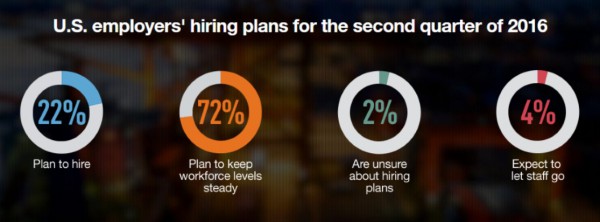More CT Employers Expect Hiring to Increase for Remainder of Year; Hartford Region Lags State
/Employers in Connecticut expect to hire at a modest pace during the fourth quarter of this year, which began on October 1, according to the ManpowerGroup Employment Outlook Survey. From October to December, 18 percent of Connecticut companies interviewed plan to hire more employees, while 7 percent expect to reduce their payrolls. Another 73 percent expect to maintain their current workforce levels and 2 percent are not certain of their hiring plans. This yields a Net Employment Outlook of 11%, which is below the national outlook projection.
“Hiring intentions are stronger compared to Q3 2017 when the Net Employment Outlook was 8%,” said ManpowerGroup spokesperson Betty Gooding. “The hiring pace is expected to remain stable compared to one year ago when the Net Employment Outlook was 12%.”
For the coming quarter, job prospects in the state appear best in Construction, Durable Goods Manufacturing, Nondurable Goods Manufacturing, Wholesale & Retail Trade, Information, Financial Activities, Professional & Business Services, Education & Health Services, Leisure & Hospitality and Other Services. Employers in Government plan to reduce staffing levels, while hiring in Transportation & Utilities is expected to remain unchanged, the survey found.
In an analysis of the largest metropolitan regions in the nation, three in Connecticut brought differing projections, with one slightly higher and the others slightly lower than overall expectations statewide.
In the Bridgeport-Stamford-Norwalk metropolitan statistical area (MSA), employers expect to hire at what is described as a “respectable pace” during this quarter, according to the Survey. Twenty percent plan to hire more employees, which is offset by the 6 percent that plan to reduce payrolls, while 72 percent of employers expect to maintain current staff levels. Two percent indicate they are not sure of their hiring plans, which yields a Net Employment Outlook of 14% - higher than the expectation statewide.
In the New Haven-Milford MSA, 16 percent plan to hire more employees from October through December and 6 percent that plan to reduce payrolls. The Net Employment Outlook is 10%, just under the state outlook. And in Hartford-West Hartford-East Hartford, 17 percent of employers plan to hire more employees, 8 percent that plan to reduce payrolls, while 70 percent expect to maintain current staff levels and 5 percent are not sure of their hiring plans. This yields a Net Employment Outlook of 9%.
Nationwide, of the more than 11,500 employers surveyed, 21 percent expect to add to their workforces, and 6 percent expect a decline in their payrolls during the final quarter of the calendar year. Seventy-one percent of employers anticipate making no change to staff levels, and the remaining 2 percent of employers are undecided about their hiring plans. When seasonal variations are removed from the data, the Net Employment Outlook is 17% nationwide.
 This marks the 13th consecutive quarter with an Outlook of +15% or stronger, according to Manpower Group. Compared with this time one year ago, hiring prospects are slightly stronger in the Northeast and remain relatively stable in the other three regions. The Northeast Region includes Connecticut, Maine, Massachusetts, New Hampshire, New Jersey, New York, Pennsylvania, Rhode Island, and Vermont. Employers across all sectors report favorable hiring intentions, with those in durable goods manufacturing reporting the strongest intentions in the past 10 years.
This marks the 13th consecutive quarter with an Outlook of +15% or stronger, according to Manpower Group. Compared with this time one year ago, hiring prospects are slightly stronger in the Northeast and remain relatively stable in the other three regions. The Northeast Region includes Connecticut, Maine, Massachusetts, New Hampshire, New Jersey, New York, Pennsylvania, Rhode Island, and Vermont. Employers across all sectors report favorable hiring intentions, with those in durable goods manufacturing reporting the strongest intentions in the past 10 years.
For the final quarter of the year, employers in Delaware, North Carolina, Wisconsin, Minnesota, Montana, Oregon, South Carolina and Utah report the strongest Net Employment Outlooks. Among the 100 largest metropolitan statistical areas, the strongest job prospects are expected in Cape Coral, Fla.; Oxnard, Calif.; Charlotte, N.C.; Stockton, Calif.; Deltona, Fla.; Grand Rapids, Mich.; Madison, Wis. and McAllen, Texas. The Net Employment Outlook is derived by taking the percentage of employers anticipating an increase in hiring activity and subtracting from this the percentage of employers expecting a decrease in hiring activity, taking into account seasonal adjustments.


 For the quarter just underway, job prospects appear best in Construction, Durable Goods Manufacturing, Transportation & Utilities, Wholesale & Retail Trade, Information, Financial Activities, Professional & Business Services, Education & Health Services, Leisure & Hospitality and Other Services. Employers in Nondurable Goods Manufacturing plan to reduce staffing levels, while hiring in Government is expected to remain unchanged, according to the projections.
For the quarter just underway, job prospects appear best in Construction, Durable Goods Manufacturing, Transportation & Utilities, Wholesale & Retail Trade, Information, Financial Activities, Professional & Business Services, Education & Health Services, Leisure & Hospitality and Other Services. Employers in Nondurable Goods Manufacturing plan to reduce staffing levels, while hiring in Government is expected to remain unchanged, according to the projections.




























